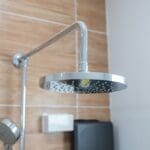Tackling a stuck shower head ball joint can feel like trying to open a jar that’s sealed tighter than Fort Knox. But don’t let frustration get the better of you. With the right approach, you can remove that stubborn ball joint without causing damage to your shower head or plumbing.
You’ll start by assessing the situation to determine the cause of the stickiness, be it rust or mineral deposits. Then, you’ll learn how to apply penetrating oil effectively, use adjustable wrenches without scratching your fixtures, apply heat to loosen the grip, and finally, clean and reassemble everything for a smoothly operating shower head.
These five steps are designed for efficiency, clarity, and to arm you with professional expertise. So, if you’re ready to conquer this plumbing challenge with confidence, let’s unveil these strategies that promise to make a daunting task surprisingly manageable.
Key Takeaways
- Examine the shower head for rust or mineral buildup.
- Apply penetrating oil and use pliers or wrench to loosen the ball joint.
- Protect the finish with tape and use adjustable wrenches to remove the component.
- Apply heat and vinegar if necessary, clean, and reassemble the shower head.
Assess the Situation
Before attempting to remove a stuck shower head ball joint, it’s crucial to assess its condition and determine whether it’s fixed or detachable. You’ll need to carefully examine the shower head for any signs of rust or mineral buildup, which are common reasons for a ball joint becoming stuck. If the ball joint is removable, your task might be simpler, but if it’s fixed, you’ll require a different approach.
First, ensure you’re turning off the water supply to prevent any accidents. Use adjustable pliers or a wrench to gently turn the ball joint counterclockwise to loosen it. It’s essential to protect the metal surfaces from damage, so consider wrapping the jaws of your pliers or wrench with tape or using a rag as a buffer.
If the ball joint refuses to budge, applying a penetrating lubricant can help. Let it sit for a few minutes to break down the rust or mineral deposits. In some cases, vinegar can be an effective alternative if you prefer a more natural solution. Remember, patience and the right technique are your allies in successfully removing a stuck shower head ball joint.
Apply Penetrating Oil
To effectively loosen a stuck shower head ball joint, start by applying a generous amount of penetrating oil directly onto the joint. This is a crucial step to remove your stuck shower head with minimal effort. Penetrating oil, such as Liquid Wrench, is designed to break down rust and corrosion, making it easier to dislodge the stuck component.
For the best results, follow these steps:
- Apply Penetrating Oil: Liberally spray or apply the penetrating oil onto the stuck ball joint. Make sure to cover it thoroughly to allow the oil to seep into any crevices.
- Let It Sit: Allow the penetrating oil to work its magic for several hours or, ideally, overnight. This waiting period gives the oil ample time to penetrate and loosen the rust.
- Attempt Removal: Use pliers or a wrench to turn the ball joint. Turn the wrench gently but firmly to avoid damaging the shower head. If the ball joint doesn’t budge, don’t force it.
- Reapply if Necessary: If the ball joint remains stuck, apply another coat of penetrating oil and wait again. For stubborn rust, consider using a wire brush to remove surface rust before reapplying the oil.
This method isn’t just efficient but also saves you from potentially having to buy a new shower head prematurely.
Use Adjustable Wrenches
After applying penetrating oil, your next step involves using adjustable wrenches or pliers for extra leverage to remove the stuck shower head ball joint. This method is crucial when dealing with an old shower head that’s become resistant to removal due to mineral deposits or corrosion.
To protect the finish of either the showerhead or the ball joint, wrap the teeth of the wrench or pliers with tape. If tape isn’t available, holding a towel over the shower head can also prevent damage.
Once you’ve safeguarded the surface, position the adjustable wrench or pliers around the ball joint. Carefully, turn the tool counterclockwise to loosen and remove the stubborn component. If the ball joint doesn’t budge, applying additional penetrating oil may facilitate the process.
After successfully loosening the ball joint, check for leaks and assess the water pressure. Low water pressure after reinstallation could indicate a need for further adjustment or cleaning.
Using adjustable wrenches not only allows you to remove a shower head effectively but also helps ensure the longevity and proper function of your shower after the procedure.
Apply Heat Carefully
If your shower head remains stubbornly in place despite previous efforts, applying heat with a hairdryer or heat gun can be an effective next step. This technique works particularly well for dissolving the bonds created by old water residue or mineral buildup, which often occurs in shower heads over time. Here’s how to proceed:
- Heat the Shower Arm: Carefully direct the heat from a hairdryer or heat gun towards the shower arm where it connects to the shower head. Ensure you don’t overheat or damage the surface.
- Watch for Signs of Loosening: As you apply heat, periodically attempt to twist the shower head by hand (wearing protective gloves is advisable). If it starts to give, you’re on the right track.
- Combine with Vinegar: If heat alone doesn’t do the trick, remove the shower head (if possible) and soak it in a heavily diluted vinegar solution to help dissolve any remaining buildup. Follow the instructions on the bottle for the best results.
- Remove and Replace: Once loose, unscrew the shower head from the shower arm. Take this opportunity to clean any visible rust or residue from the threads and apply fresh tape before installing a new or cleaned shower head.
This method should make it easier to remove stubborn shower heads without causing damage. If it remains stuck, it might be time to call a professional.
Clean and Reassemble
Once you’ve successfully removed the shower head, it’s crucial to thoroughly clean and reassemble it to ensure optimal performance.
Start by preparing a showerhead finish-safe cleaning solution bath to soak the shower head. This simple, yet effective method dissolves mineral build-up that can clog and hinder water flow. Submerge the shower head in the finish-safe cleaning solution bath for at least an hour, but for best results, leave it overnight.
After the soak, rinse the shower head thoroughly under running water. Use a soft brush to remove any lingering deposits. This step is vital for restoring full water flow and ensuring your new shower feels truly refreshing.
Next, inspect the shower hose and shower arms for any signs of damage or wear. Replace any faulty parts to avoid leaks or other issues.
Before reattaching the shower head to the shower faucet, remove any old plumbers tape from the threads. Apply new tape carefully, making sure it’s wrapped securely to prevent leaks. Once you’ve done this, screw the shower head back on, hand-tightening it to avoid damaging the threads.
Frequently Asked Questions
How Do You Remove a Shower Head That Won’t Budge?
If your shower head won’t budge, wrap the jaws of adjustable pliers or a wrench with tape to protect the finish, then gently turn it counterclockwise. If needed, leverage with a towel for extra grip.
How Do You Remove a Stuck Shower Arm?
To remove a stuck shower arm, you’ll first need to secure it with an adjustable wrench or pliers, protecting the finish with a cloth. Then, turn it counterclockwise to loosen and detach it.
How Do You Remove a Stuck Shower Fixture?
To remove a stuck shower fixture, you’ll need adjustable pliers or a wrench. Wrap the tool’s teeth with tape to avoid scratches, gently turn counterclockwise, and then twist off the fixture by hand.
How Do You Remove a Twisted Shower Head?
To remove a twisted shower head, you’ll need pliers or a wrench. Wrap the tool’s teeth in tape to avoid scratches, grip the shower head gently, and turn it counterclockwise until it’s free.





